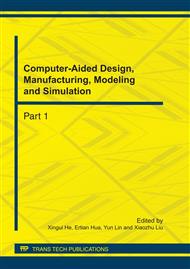p.42
p.46
p.50
p.56
p.60
p.67
p.72
p.77
p.82
Design and Analysis of an Omni-Directional Mobile Robot with Orthogonal Wheel
Abstract:
This study presents the processes undertaken in the design and implementation of an omni-directional mobile robot using orthogonal wheels. The orthogonal wheel developed consists of ten rollers, achieves not only forward, reverse, left slide, right slide, but also rotation in situ. The mobile robot consists of four orthogonal wheels which independently powered by brushless DC motors. A DC industrial motherboard is adopted in the main controller, which constitutes a NMT network with the communication ports of four motor drivers by an extended CAN card. In the NMT network, the host computer is the CAN node master, and each motor driver is the CAN node slave. The host computer controls each motor’s movement, and reads the motor’s current, position and speed information through the NMT network in real-time. The experiment shows that the mobile robot can achieve omni-directional movement.
Info:
Periodical:
Pages:
60-64
Citation:
Online since:
August 2011
Authors:
Keywords:
Price:
Сopyright:
© 2011 Trans Tech Publications Ltd. All Rights Reserved
Share:
Citation:


